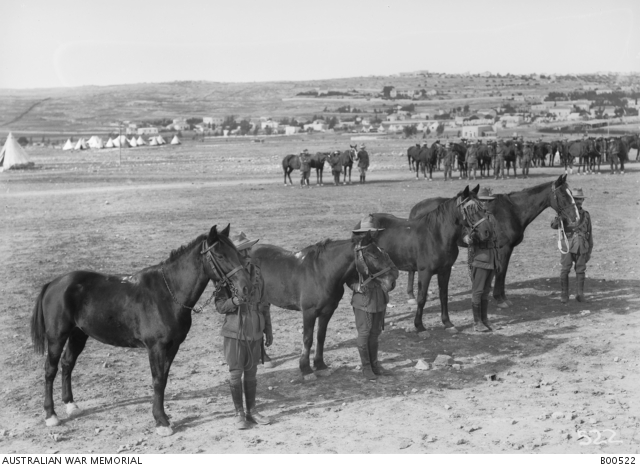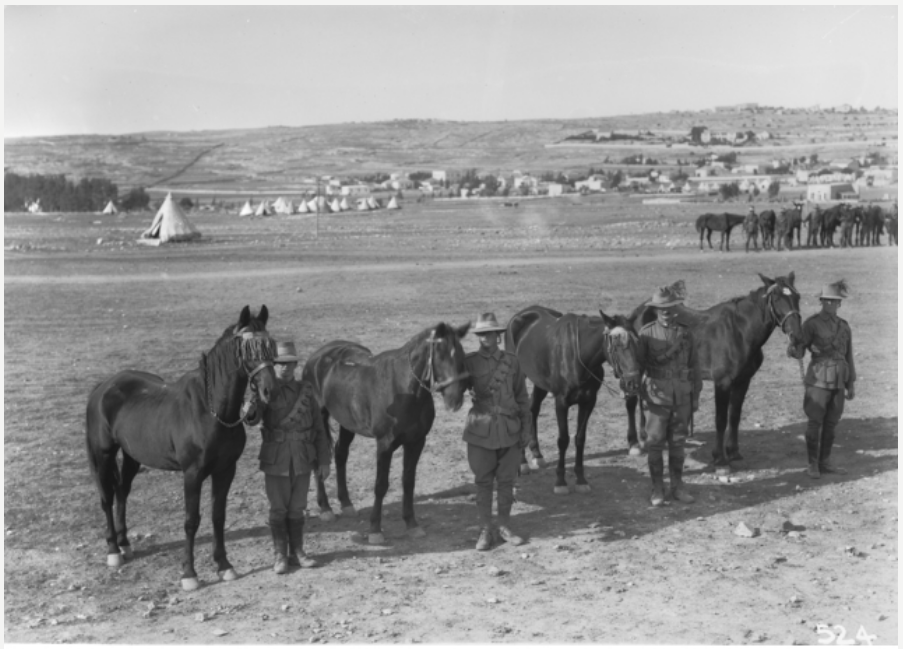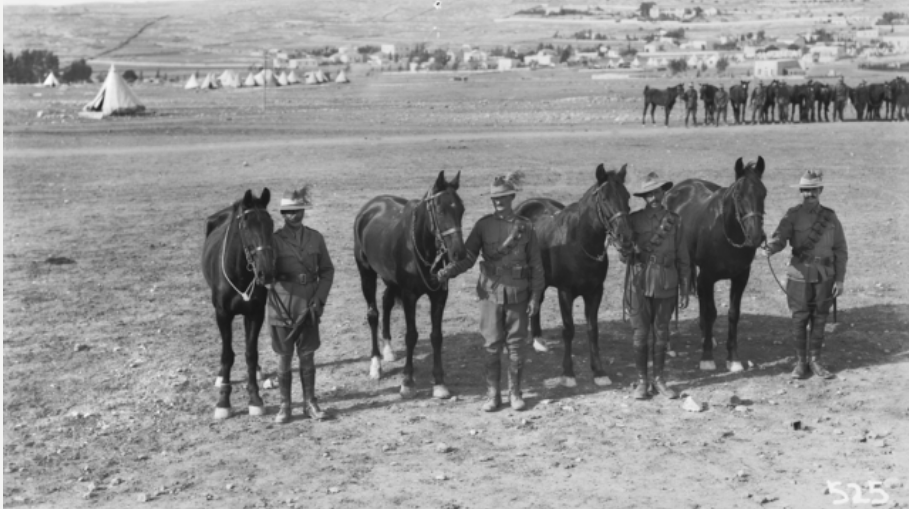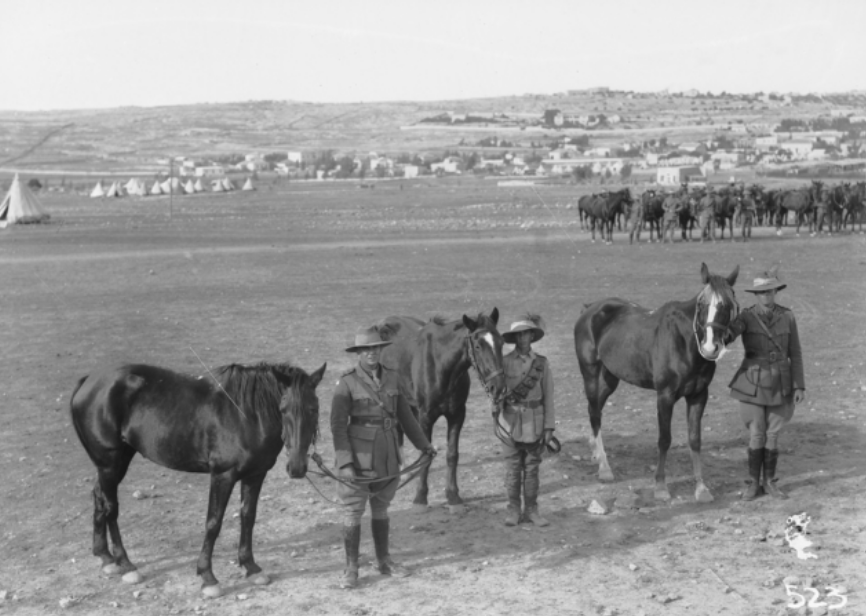Known Historical Waler Names from WW1

Image: “Group of four original horses: ‘Billy’, ‘Cambo’, ‘Tommy’ and ‘Saida’, and unidentified members of the 2nd Australian Light Horse Regiment. Ottoman Empire: Palestine, Jerusalem. November, 1918.” AWM.
It’s not unusual for old photographs relating to WW1 to show a name for the person in the photo but not the horse.
We think the horses should also be acknowledged by name for their service. We started collecting horse names that do appear in photographs from that time to at least raise the profile of those few names we do have and would love more!
Abdul In photo of group of four original horses: ‘Joe’, ‘Abdul’, ‘Charlie’ and ‘Mick’, and unidentified members of the 2nd Australian Light Horse Regiment. Jerusalem, Palestine, November 1918. AWM
Also Ran In photo of group of three original horses: ‘Britt’, ‘Fat Jack’ and ‘Also Ran’, and unidentified members of the 2nd Australian Light Horse Regiment. Jerusalem, Palestine, November 1918. AWM
Anzac Two veterans, Driver Steve Murphy of the 22nd Battalion, and the horse ‘Anzac’ in charge of which he sailed from Australia with the original 22nd Battalion on 8 May 1915. They served throughout together, ‘Anzac’ being one of the very few Australian horses to last out the campaign without becoming a casualty.
In 1918 the loss of horses in the Transport Section was very heavy owing to the fact that the limbers used to be taken nightly almost into the front line in order to save men the fatigue of carrying parties. Losses from shellfire were a common occurence. ‘Anzac’ had a full share of these dangers and on demobilization was sent over to England and sold.’
Photo taken 31st May, 1918, at Picardie. AWM
Aristocrat Chauvel riding Aristocrat through Damascus. AWM photo H10659
Baldy Sir Harry Chauvel’s horse. Given to Lieut-Col Farr end of war, who used him as a charger in Aleppo 1919, then to England with Farr.
Bill (the bastard) Numerous sources.
Billy Sergeant Major D E Trevanion’s horse ‘Billy’ winning the ‘Dinkum Diamond Thousand’ race, watched by a crowd of soldiers, officers and civilians at the 2nd Australian Division race meeting. AWM photo.
And… Group of four original horses: ‘Billy’, ‘Cambo’, ‘Tommy’ and ‘Saida’, and unidentified members of the 2nd Australian Light Horse Regiment. AWM photo. All in list.
Bing Major Harris’ of the Anzac Mounted Division original horse, which was wounded four times. AWM photo taken in Rishon, Palestine, 1918
Blue Norman Charles Halliday, known as ‘Saltbush Bill’, of the 9th Light Horse overseas in the desert during World War I with his horse ‘Blue’. AWM photo.
Bobbie The horse Bobbie which joined the 2nd Battery of the Australian Field Artillery, AIF, in September 1914 as an officer’s charger for Lieutenant J.C. Selmes DSO. The horse retired in December 1918.
Bobs Two horses belonging to General Cox. AWM
Brisbane – presented to George V. Think bred at Rewan Awful behaviour.
Britt In photo of 3 original horses Jerusalem, Nov. 18 AWM.
Cambo (see Billy).
Charlie (see Abdul).
Clipper Clipper, a favourite horse of Lieutenant (Lt) Rupert Delamere Brent, 2nd Tasmanian Imperial Bushmen, and his unnamed groom. Lt Brent later served in the First World War as a captain with the 13th Light Horse Regiment, and in the Second World War as a sergeant with the 2nd Military District (NSW) accounts office. AWM.
Cossack ‘ Maadi, Egypt. c. 1917. Major N.D. Barton of the 7th Australian Light Horse Regiment with his horse Cossack in a camp near Cairo. (Donor Major N.D. Barton).’ AWM
Danger Palestine. 1918. An Australian soldier and his black gelding horse named Danger which won the NCOs race at a 2nd Australian Field Ambulance sports meeting.
Darkey Pompey (Harold Edward) Elliott’s horse WW1.
Dick: From a photograph of Captain (Capt) John Henry Jose, 5th Divisional Artillery, of West Leederville, WA on horseback. Written on the back of the photograph is: “My horse Dick/ I’ve had him nearly/ two years/ H”.
Dipso ‘Dipso’, a race winner and one of the original horses of the 6th Australian Light Horse Regiment. ‘Dipso’ was reared at a station near Dubbo, NSW, and was originally owned by Reginald Roy Brown. Brown enlisted with the 6th Light Horse Regiment on 27 October 1914 and with ‘Dipso’, he embarked from Sydney, NSW, aboard HMAT Suevic on 21 December 1914, bound for Egypt. Brown served at Gallipoli where he became ill, eventually being evacuated to a hospital in England. While recovering in England, he accepted a commission into the Royal Field Artillery and did not see ‘Dipso’ again. Brown later won a Military Cross but was killed in an accident in October 1918. It was said, that prior to his evacuation to England in 1915, Brown gave ‘Dipso’ to his commanding officer, Captain, (later Major, DSO), Stuart Archibald Tooth who used the horse for the duration of the war in the Sinai and Palestinian campaigns. Major Tooth survived the war and returned to Australia on 28 June 1919. Note – Tb looking; says is a Tb in another post on him.
Dolly Horse and Sulky. Frederick Richardson of Waverley. Next to Waverley police station with his sons Allan and Cecil. Horse named “Dolly”, Bronte Road. Archives.
Fat Jack In photo of 3 original horses Jerusalem, Nov. 18 AWM.
General (see Hamish).
George, a bay gelding, was bred at Springvale Station, a 1.02 million acre cattle station in the channel country of Western Australia, one of the many pastoral holdings owned by the Milson family. Pte Milson, a stockman before his enlistment on 31 December 1914, brought George with him from his home at Milsons Point, Sydney. AWM
Ginger Officer mounted on Ginger, an Australian lighthorse,Thuin, Belgium, 1919 State Library, S.A. Also : SURAFEND, PALESTINE. 1918-08. CAPTAIN J.D. CRAMB, 14TH AUSTRALIAN LIGHT HORSE REGIMENT (14ALH), MOUNTED ON HIS HORSE “GINGER”. (DONOR CAPTAIN J.D. CRAMB)
Gus 1917… Trooper Harry Riseborough and his mount ‘Gus’ during training at Officer School, Jordan.
Hamish Horse drawn steam fire engine with horses Hamish and General in front of Perth Fire Station. State Lib. W.A.
Havelock Light Horse soldier on “Havelock” – Bega, NSW. 1910. State Lib, NSW.
Hector Horse drawn steam fire engine with horses Hamish and General in front of Perth Fire Station. c. 1905.” State Library of Western Australia photo.
Hero (see Hector).
Hindenburg Mount of General Allenby, rode him to the Jaffa gate etc. Had him put down in Egypt after he eft there after being High Commissioner.
Ike Trooper Bert Billings, 1st Light Horse Signal Troop; Ike was killed by artillery shell at Romani, Billings kept a lock of Ike’s hair to remember him by. Exhibited at Shrine of Remembrance, Melbourne.
Irish Ravelsberg, Belgium. 1917-06. Portrait of 10873 Private Robert Keating, 2nd Australian Motor Transport Company (AMTC), mounted on “Irish” the winner of 1st prize at the 3rd Division horse show. (Donor P. Tehan)
Jack General Sir William Birdwood’s horse, gifted in 1919 to the King.
Joe (see Abdul).
Lady SURAFEND, PALESTINE. 1918-08. LIEUTENANT HOLLAND, 14TH AUSTRALIAN LIGHT HORSE REGIMENT (14ALH), MOUNTED ON HIS HORSE “LADY”. (DONOR CAPTAIN J.D. CRAMB) AWM.
Mena Daily Telegraph (Sydney, NSW : 1883 – 1930), Monday 19 July 1920, page 5 ‘At the forthcoming Aldershot Army Horse Show, In the veterans’ class, Mena, the charger ridden by Colonel Marsh throughout the war, will be exhibited. The horse came from Melbourne In August, 1914: remained In Egypt till 1916, and then went to France, and was with the Eighteenth Australian Division until the armistice.’
Mick (see Abdul).
Midnight Guy Haydon’s horse. Extensive internet sources.
Moscow ridden by Major Bice in 1916 one of the few of the first regimental horses there. Bred by Alfred Barker at Narrabri, NSW (Sire Rexona) and killed at the Battle of Beersheba.
Old Bill “Postcard written by Light Horseman Lieutenant Dudley Townley to Freda Gwyn, dated 15 November 1918. The front features a photograph of a horse named ‘Old Bill’, who the inscription indicates boarded for war with the Australian Light Horse in 1914. Horses ridden by the Light Horsemen were not allowed to return to Australia under quarantine rules. Old Bill may have been transferred to the Artillery sold or killed after the photo was taken. Museums Victoria photo.
Outlaw, the G.S. Millar’s horse. photos in Egypt.
Pascha Portrait of 68 Private William John Crook, 1st Divisional Australian Army Service Corps, of Wonthaggi, Vic. He is mounted bareback, with one leg casualy slung over the horses’ wither, on ‘Pascha’, a black horse of General Bridges’ at Mena Camp, Egypt.” AWM
Paska (see Sultan).
Patch ‘Patch’, Lieutenant Colonel J D Richardson, Commanding Officer of the 7th Light Horse Regiment’s (7ALH) original charger. This horse went right through the campaign and never once required the services of the ‘Vet.’
Piggy Piggy belonged to Edwin Welch, a surveyor. Surveyors needed tough horses as they mapped out our vast land, being away for months at a time, their horses living off the land; often in very hard country.
Piggy is also famous for getting through a tough mission with aplomb when Welch accompanied the Howitt expedition that looked for Burke and Wills. It was Piggy’s fitness, courage and jaunty character that led him to be in the vanguard of the search. He had been named not for his temperament, but for his excellent survival sense. When horses were turned out for grazing, Piggy was often last to be found, wandering to wherever the best feed could be found. During a spell at Blanchewater on the trip, Piggy was AWOL for 2 days. At times on the tough trip, the horses went up to 36 hours and more without a drink, and sometimes 24 hours without feed. Piggy however, out performed the camels brought along. One day, the 15th September 1861, Piggy and Welch were well in front of the rest at Cooper Creek, when Piggy’s keen interest in some humans (has u carrots? apple? anyfing?) led him to some wurleys belonging to friendly Aboriginal people, and sitting in one was a thin sad man in rags – John King, the last survivor of the Burke and Wills expedition. The people had been kindly looking after him, having found him after he had almost starved to death. Howitt had brought gifts along in case of this event and the people were overjoyed to receive them.
Despite having nothing for Piggy, King was overjoyed to see him! The horses had been bought for the expedition,16 tough bush horses. Welch, himself a good bushman, became very fond of Piggy and brought him all the way back home to Victoria.
The painting of Piggy, gouche on buff card, was done by Frank (Francis) Mahony in February 1887. Piggy was described as dark grey with a white patch on his forehead.
Ping Pong Mount of General Meredith. Always given to Lambert, the war artist, to ride.
Plain Bill General L. Ryrie’s horse.
Portland Jimmy Colonel Kendall’s racehorse Portland Jimmy, Sinai, Rafa. AWM photo B00890.
Prance (see Topsy)
Prince Major General Sir Henry W Hodgson mounted on his horse ‘Prince’, standing in a river. Note the mud walls on the sides of the river. Syria: Damascus. AWM photo.
Prema – Gautam Das’s 1968 imported to India Waler.
Punch Outdoor portrait of 165 Trooper Thomas Francis Burges and his horse Punch waiting to embark for overseas service with the 10th Light Horse Regiment. A farmer from Geraldton prior to enlistment, he embarked from Fremantle aboard HMAT Mashobra on 8 February 1915 for Egypt and then to Gallipoli in May 1915. He was promoted to Lance Corporal in June 1915. L Cpl Burges was killed in action at Walkers Ridge, Gallipoli, on 7 August 1915. He was aged 27 years. AWM.
Quondong An unidentified soldier atop a horse named ‘Quondong’, the winner of numerous races at Australian Corps Meetings. Note the ribbon around Quondong’s neck reads ‘2nd Australian Div Artillery Dinkum Diamond … winner of Champion ?Thuin, 16th March 1919’. AWM.
Rosie (WW1 from Ros Sexton, Fidler interview ABC).
Saida (see Billy.)
Sally France c. 1917. Lieutenant Colonel Frederick William Godsby Annand of the 2nd Pioneer Battalion. AIF, mounted on his horse Sally. AWM
Sandy Maj-Gen Bridges mount.
Scarsdale: the mount in Egypt of Quarter Master Sergeant George Daniel, 8th Light Horse Regiment, 3rd Light Horse Brigade. Scarsdale was killed in action near Jerusalem mid-1918.
Scratcher Bethal, South Africa, 1901-12-12. NO. 1459 Trooper Francis Gilbert Halstead of B Squadron, 2ND New South Wales Mounted Rifles, with his horse named SCRATCHER,
“TAKEN JUST OUT FROM BETHAL ON DECEMBER 12TH. SCRATCHER CARRIED ME FAITHFULLY & WELL FROM JULY 23RD TILL FEBRUARY 20, WHEN HE BROKE DOWN, AFTER A HEAVY NIGHT MARCH ON 19TH & A STIFF GALLOP THE FOLLOWING MORNING, WHEN WE CAPTURED TRICARDT’S COMMANDO AT NOOITGEDACHT.”
Shamrock Shamrock, the horse, harnessed to Gympie’s fire cart in 1914. Horsedrawn fire cart outside Gympie’s fire brigade building. State Lib. Qld.
Shenalte-je France. 19047 Gunner (Gnr) Arthur Burton MM DCM on a horse called Shenalt-je(?). Gnr Burton was awarded the Military Medal for maintaining communications under heavy shellfire on 7 June 1917 at… AWM
Silver Portrait of Arthur Guy MacKinnon mounted on his horse ‘Silver’ at a camp at Mona Vale station. A pastoralist from Conara, Tasmania, 672 Arthur MacKinnon served with the 22nd Light Horse in the years preceeding the Second World War. TX2133 Arthur MacKinnon enlisted on 2 August 1940, serving with 6 Division Cavalry Regiment in the Middle East and New Guinea, where he attained the rank of Captain.
Snowy Two original horses, ‘Snowy’ and ‘Bobs,’ belonging to General Cox. AWM
Socks SURAFEND, PALESTINE. 1918-08. LIEUTENANT HOLLAND, 14TH AUSTRALIAN LIGHT HORSE REGIMENT (14ALH), TAKING HIS HORSE “SOCKS” OVER A JUMP. (DONOR CAPTAIN J.D. CRAMB) AWM.
Steamboat Q3747 (later QX40903) Lieutenant (Lt) (later Captain) Sydney Swain Appleby, 2/14 Light Horse Regiment (Queensland Mounted Infantry), on his horse ‘Steamboat’ at Southport showground. The 2/14 Light Horse paraded in Southport for the last time before being disamalgamated in December 1940. Lt Appleby later enlisted in the Second AIF and served with the Far East Liaison Office (FELO) in Hollandia, Morotai and Labuan. AWM.
Sultan “South Australian Fire Brigade horses, Sultan and Paska. c.1912.” State Library of South Australia.
Sydney Francis Ingall, The last of the Bengal Lancers (his book).
Taffy “Sig. Corp. A. W. Edwards, 1st Light Horse Regt. in Palestine. Taffy [horse] 16/11/16.”
Tango Major Hudson, of the 1st Australian Light Horse Brigade, and his horse, Tango, trudging across the barren desert, Jam. 1918, AWM.
The Outlaw Trooper G. Miller, Museums Victoria photo and info.
Tim: Major Arnold Brown’s horse named Tim. Major Brown was with the 28th Battalion which saw service on Gallipoli, and the Western Front including the Somme, Pozieres, Poelcappelle and Bullecourt.
Toby Portrait of Captain Francis Edgar Williams, originally 32nd Battalion and now part of the Dunsterforce, riding a chestnut horse named ‘Toby’ through the countryside of the Persian Plateau. Persia 1918. 1st Australian Wireless squadron. AWM
Also Toby, Bob Reeves on Toby in England during WW1 (Aussie-mobs on Flickr).
Toddy “A group on horseback at a tombstone. The original caption reads “Captain Bryant and grooms breaking at the tombstones 9 weeks after the scrap in which Lieutenant Slattery was killed. Turkish redoubts were all round this tone. The tombstone was erected by King somebody before Napoleon’s march to Gaza in 1767 and now knocked about by our artillery on 17 September 1917.” Capt Bryant was a 32 year old gardener from North Walkerville, South Australia when he was appointed a Second Lieutenant in the AIF on 23 March 1915. He embarked for overseas with C Squadron, 11th Light Horse Regiment from Brisbane on 2 June 1915 aboard HMAT Medic (A7). He served at Gallipoli and in the Middle East and was promoted to Lieutenant on 28 January 1916 and to Captain on 30 May 1917. Capt Bryant was Mentioned in Despatches (MID) for his courage during operations in September and October 1917. His recommendation reads “This was particularly noticeable during the fighting among the olive groves and vineyards north of Damascus on the 1st October when he personally pushed his guns to within 50 yards of the enemy rear-guard, and that days fighting resulted in the capture of 744 prisoners, 3 mountain guns and 80 machine guns.” This image is from the collection of 1328 Private Richard Goldsmith Hummerston, 10th Light Horse Regiment and 3rd Light Horse Brigade Machine Gun Section.” AWM
Tommy KANTARA, EGYPT, 1916. SERGEANT FRANK ALEXANDER WEEKS, 1ST AUSTRALIAN LIGHT HORSE REGIMENT, WITH HIS RACE HORSE TOMMY. INSCRIPTION: “HE CAME THIRD IN THE RACE WE HAD LAST WEEK. HE IS A GOOD TROTTING PONY.” (DONOR F. GILSHENAN)
Tommy (see Billy). + 19 October 1940. Farrier Fred Barnes shoeing Tommy, the Auxiliary Horse Transport’s favourite horse. Holding Tommy’s bridle is Driver Ted Ortan who served in the Boer War as well as the First World War. In the background is Head Farrier Albert Drew at the forge, making new horseshoes. (Donor D. Stevenson). AWM.
Topsy and Prance artillery wheelers, AWM photo COO118.
Tuppence Neil Bruce of the 10th Light Horse Brigade. c 1914 Mount Hawthorn.



Images left to right:
Group of four original horses: ‘Joe’, ‘Abdul’, ‘Charlie’ and ‘Mick’, and unidentified members of the 2nd Australian Light Horse Regiment. Jerusalem, Palestine, November 1918. AWM
Major Birkbeck’s team of four of the original horses and unidentified members of the 2nd Australian Light Horse Regiment. Jerusalem, Palestine, November 1918. AWM
Group of three original horses: ‘Britt’, ‘Fat Jack’ and ‘Also Ran’, and unidentified members of the 2nd Australian Light Horse Regiment. Jerusalem, Palestine, November 1918. AWM